#obeah man in trinidad
Explore tagged Tumblr posts
Text
https://bestservicesprovider.com/best-obeah-man-in-trinidad-and-tobago/
Best Obeah Man in Trinidad and Tobago right here to assist his customers.Voodoo Expert offer strategies to remove voodoo spell.He is Voodoo Spells Specialist

#Best Obeah Man in Trinidad and Tobago#Voodoo Expert in Trinidad and Tobago#Voodoo Spells Specialist in Trinidad and Tobago
0 notes
Text
Caribbean Soul Music in 16 tracks
Caribbean Soul is a melting pot of styles. You can hear Calypso, Funk, Reggae, Afro, Soca, Latin, Gospel and Soul. Strutting basslines, funky steel pans and a tropical vibe are the main ingredients for Caribbean Soul.
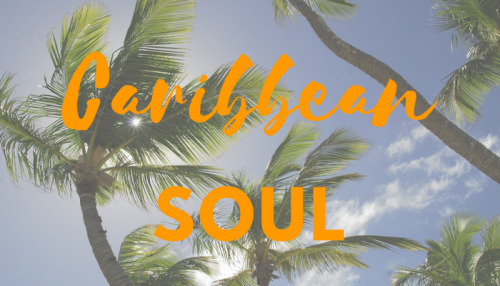
Arrêté Mal Palé - Fair Nick Stars (Fair-Nick Stars, 1978) - Guadeloupe
Basa Bongo - The Yoruba Singers (Basa Bongo / Black Pepper, 1975) - Guyana
Black People - Rolph Marcial (Black People / Now You've Got It, 1976) - Trinidad & Tobago
Black Man's Cry - Lever Brothers Gay Flamingoes (Secrets Of The Pan, 1973) - Barbados
Blow'Way - Lancelot (Afro'Dadian / Blow'Way, 1971) - Trinidad & Tobago
BRC's Groove - Blue Rhythm Combo (Magumba , 1972) - Barbados
Exuma, The Obeah Man - Exuma (Exuma, 1970) - Barbados
Gimme Some More - The Troubadours Of Barbados (No Balls At All / Gimme Some More, 1973) - Barbados
I'm In A Dancing Mood - King Sporty (Don't Kill The Goose / I'm In A Dancing Mood, 1971) - Jamaica
Instant Groove - The Belles Combo Of Dominica (Instant Groove / Un May Que, 1973) - Dominica
Jerk Vidé - David Martial (Lucie, 1966)
The New Bag - The Exciters (Conozco A Los Dos, 1971) - Panama
Ou Qué De Moin - Monsieur X (Ou Qué Di Moin / Je Demande Qui Je Suis, 1970) - Guadeloupe
Red Light Lady - Ophélia (Ophélia, 1979) - Dominica
Spouge explosion - Aubrey Mann & The Lunar 7 (Here I Am Come And Take Me / Spouge Explosion, 1976) - Barbados
Ti Gaçon - Ibo Combo (Café, 1972) - Haiti
More Soul Soungs
Soul from Panama in 12 tracks
Caribbean Soul: 20 awesome tracks
Jamaicans Got Soul
#Caribbean Soul Music#Soul#Soul Music#Soul Music Songs#Music#Music Songs#Caribbean Soul#Soul Music List
5 notes
·
View notes
Text
SOCA THERAPY - MAY 11, 2025

Soca Therapy Playlist
Sunday May 11th 2025
Making You Wine From 6-9pm on Flow 98.7fm Toronto Her Mudda (Dr. Jay Plate) - Pumpa Fitness - Trinidad Killa x Jadel You Alone - Imani Ray x Preedy BessFren - Nailah Blackman x Ding Dong The Great Escape - Patrice Roberts Road Meeting - Fay-Ann Lyons x Syri Lyons x Travis World Carry It (Mr Vik Band Edit) - Bunji Garlin Pardy - Machel Montano
Aye Aye Aye - Square One All Night - Donella Weekes Take A Wine - Bud
Watching Me - Gailann x Benjai Wishful Encounters - Bunji Garlin My Love Will Never Die - Da Bhaan Spanish Fly - Ataklan
Tabanca - Mical Teja Next Gyal - GBM Nutron The Truth - Machel Montano No Sweetness - Kes The Greatest Bend Over - Yung Bredda Good Spirits - Full Blown Forget About It - Kerwin Du Bois
Brain Freeze - Leadpipe x Jus-Jay 10 Outta 10 - Machel Montano People Business - Teddyson John x Skinny Fabulous Wutless - Th3rd Warming Up - Adam O x Akaiiusweet
Juice - Pumpa
TOP 7 COUNTDOWN - Powered By The Soca Source
Top Songs Streamed In British Virgin Islands on Apple Music (World Category)
7. Best Life - Xclusive Sounds feat. Jarvy
6. Vent - Teddyson John feat. International Stephen 5. Anxiety - Patrice Roberts 4. Wine & Dip - Adam O x Marvelus 3. Dansa - Klassik Frescobar 2. Blessing - Blaka Dan
1. Bouwey - 1T1 feat. Theomaa
Socamazing - Adam O
Bro Code - Hunter x Jab King Sound Check - Mad Skull x Wetty Beatz
Shake The Place - Machel Montano x Destra
Bacchanal - DestraIn The Meantime - Alison Hinds
Saucy Baby - Denise "Saucy Wow" Belfon
Illegal - Machel Montano
Boss - Benjai
Be Humble - Maximus Dan Mother & Wife - Bunji Garlin Old Woman Alone - Tallpree Toot Toot - Temptress
Bag Ah Sugar - Terra D Governor
Ivy - Terra D Governor Pink Panther (Bouyon Remix) (DJ Shy Intro) (4) Big Phat Fish - Machel Montano & Xtatik Music Farm - Xtatik Stalker - Machel Montano Obeah Man - Maga Dan Wine Dem Out - Dawg E. Slaughter Kaise Bani - Rikki Jai Soca Billboard - General Grant
Take Me Home - Freetown Collective
PAN MOMENTS Woman On The Bass - Neal And Massy Trinidad All Stars
TANTY TUNE (1978) Sugar Bum Bum - Lord Kitchener
NORTHERN PRESCRIPTION MAS - JFiyre
Play Mas - Teddyson John x Lyrikal
True Masquerader - Kes The Band State Of Mind - Destra She Coming - Machel Montano Spoil Mehself - Kerwin Du Bois Loner - Lyrikal
Ducking - Fadda Fox
When Tomorrow Comes - Don Trent
Too Own Way - Voice In Meh Space - Nadia Batson Slip In - Geo
Eating Cat (Meow Meow Meow) - Suhrawh x Rawsheid Kitty Cat - Square One feat. Andy Armstrong
Tiger Baby - Militant
Tiger Baby - Salty x Militant x Travis World Throwback - Ding Dong Disco - Lucrativ x Lord Nelson Hello - Kes Cocoa Tea - Kes Carnival Darling - Coutain x GBM Nutron Ungrateful (Clean) - Patrice Roberts
Follow Dr. Jay @socaprince and @socatherapy
“Like” Dr. Jay on http://facebook.com/DrJayOnline
0 notes
Text

can I say that I've been yapping at this app about the vampire verse and it's made this massive flo chart and bullet points of what me ( and my brother ) have mentioned or said and lemme tell ya, just moving it over to Discord makes me realize we've YAPPED and that bitch—ion know what the fuck to do with it all. how the hell would I even begin to compile it into a verse.
I've read nothing but stuff about the different African Vampires and Caribbean Vampires. which are—to no one's surprise— VERY similar. and for some reason all seem to fear like spices and RICE. it sends me to the moon and back. but interesting enough is the way that the Haitians themselves define a rougarou vs Louisiana Natives.
what Bakuna has learned so far.
Vampire myths exist across many African and Caribbean cultures, often blending indigenous beliefs with colonial influences. Unlike the European vampire, these creatures tend to be spirits, shapeshifters, or entities tied to witchcraft:
African Vampire Myths
Adze (Ewe people – Ghana, Togo, Benin).
The Adze is a vampiric spirit that can transform into a firefly to slip through cracks in houses.
It drains the life force of its victims, especially children, through blood or energy consumption.
If caught in human form, it becomes a regular person, but with supernatural abilities.
Sasabonsam (Akan people – Ghana).
The Sasabonsam is a bat-like creature with iron teeth and hooked feet, living in the forests.
It hangs from trees and drops down to attack travelers, draining their blood.
Some legends say witches can summon it for power.
Impundulu (Xhosa & Zulu – South Africa).
The Impundulu, or "Lightning Bird," is a vampiric familiar used by witches.
It appears as a massive bird that can turn into a man and seduce victims.
It drinks blood and causes illness, serving its witch master until passed to another.
Obayifo (Akan – Ghana, Ivory Coast, Togo).
A witch-like vampire that drains the blood and energy of children.
It appears as an ordinary person during the day but emits a glowing light at night.
Some believe the Obayifo causes crops to wither and famine to spread.

Jamaican Vampire Myths
Rolling Calf ( I don't know EXACTLY where this hails ).
A vampiric spirit in the form of a massive, fiery-eyed calf wrapped in chains.
Said to be the spirit of an evil person or wicked butcher, cursed to roam at night.
It attacks travelers, chasing them down before draining their life force.
Old Higue (Jamaican Obeah tradition – also found in Guyana & Trinidad).
An old woman vampire who sheds her skin at night and turns into a ball of fire.
She sneaks into homes and sucks blood from babies.
To stop her, people scatter rice at the doorstep—she is obsessed with counting and will be trapped until sunrise.
Duppy ( not sure about this one either ).
While not strictly a vampire, some duppies (ghosts/spirits) act vampiric, feeding on the living.
Obeah men and women can control or summon them to attack enemies.
A duppy that drains life force might be linked to the soul of a wicked person who wasn’t properly buried.

Haitian Vampire Myths
Loogaroo (Haitian Vodou & Caribbean folklore).
Similar to the Old Higue, the Loogaroo is a witch who makes a pact with the devil, gaining power in exchange for blood.
She sheds her skin at night, turning into a glowing orb to hunt victims.
If she doesn’t collect enough blood, the devil punishes her.
Like the Old Higue, scattering grains of rice or sand forces her to count them, trapping her until dawn.
Zobop / Loups-Garoux.
Secret societies of sorcerers said to be capable of flying and drinking the blood of victims.
Some stories describe them as shape-shifters who can turn into animals or mist.
They often attack at night and are believed to be responsible for sudden deaths and disappearances.
Bakulu-Baka.
A lesser-known Haitian legend about a vampiric spirit that possesses a living person, making them crave blood.
Victims become violent and unpredictable, much like the European idea of vampiric possession.
These spirits are feared in rural communities and are said to be exorcised through Vodou rituals.

Each of these myths reflects local beliefs in spirits, the afterlife, and supernatural forces. Many are tied to ideas of justice, punishment, or witchcraft, making them distinct from the classic European vampire.

#✟ ⸻ 𝕾𝖆𝖎𝖓𝖙 ⟢ ❨ 𝗢 𝗢 𝗖 ❩.#bakuna YAPPING#i figured it'd be nice to show some people who don't know some of these#it's finny to me how they dont necessarily feed off of blood#they feed off of energy; usually lofe energy
6 notes
·
View notes
Text
Why should you get in touch with an experienced Obeah man in Trinidad?
Obeah is a form of religious practice comprising different rituals, even magical spells, originating among the Afro-Caribbean population, hailing from Western Africa, and currently residing in the West Indies. Obeah is comparable to Voodoo, Haitian Vodou, Palo, and Santería, as well as similar other practices where the practitioners establish communication with their ancestors and spirits.
Many of the rituals of Obeah have to do with healing, and as a result, this practice is deeply connected with the spiritual beliefs of the people, coming from Africa and now living in the West Indies. Even though Obeah was declared illegal in Jamaica back in 1760 and most people practice it openly, many men and women in West Indies practice this religion in their day-to-day lives. Most people outside the Afro-Caribbean diaspora community are not even aware of the existence of Obeah and its practice.
One of the things that make Obeah or Obecyahism different from Voodoo is it lacks any organized creed or method of worship. While a lot of people consult with an Obeah practitioner because they want to receive healing, it is essentially associated with magic, sorcery, invocation of spirits, and fetishism. A lot of people in the past used to work with Obeah when they needed to make love potions that could be used to attract another person with whom he or she shares an interest. An Obeah man in Trinidad can consider the individual requirements or problems of his client and come up with spells and potions to resolve them.
For people with a strong faith in Obeah, it works as a powerful method to remedy all kinds of problems in life. Obeah has also been actively used for managing career problems, health issues, competition among business owners, mental anxiety, and other problems that people may face in their daily lives.
Over the years, Obeah has evolved into a process of cursing others and controlling and manipulating their lives. It is a reason many people consult with Obeah practitioners, as they can have the peace of mind they need knowing that they are safe from someone using Obeah to control their lives.
As with any other magical practice, there are positive and negative aspects of Obeah that can impact its users in different ways. If you are troubled in your life for some reason, and you need to have the support of an Obeah practitioner who can consider your issues and recommend the best measures, you should reach out to an Obeah expert in Trinidad who can get you the best solutions. These professionals have many years of experience with Obeah. Hence, this makes it possible for them to bring peace to their clients.
Through the practice of Obeah, it is possible to invoke the spiritual forces that surround a human being and impact that person’s life in myriad ways. The unique thing about Obeah is that it is not a one-track system of belief but encompasses many different ideas and beliefs.
People within the African and West Indian communities strongly believe that an Obeah man is the ultimate spiritual counselor they need when trying to manage the difficulties in their lives. It is no wonder that an Obeah man is well-regarded with great respect in the community. So once you have decided that you are going to consult with an Obeah man who can help you to remedy the issues that you have been facing for some time, make sure that you get in touch with a Trinidad-based Obeah man for the best results.
4 notes
·
View notes
Photo
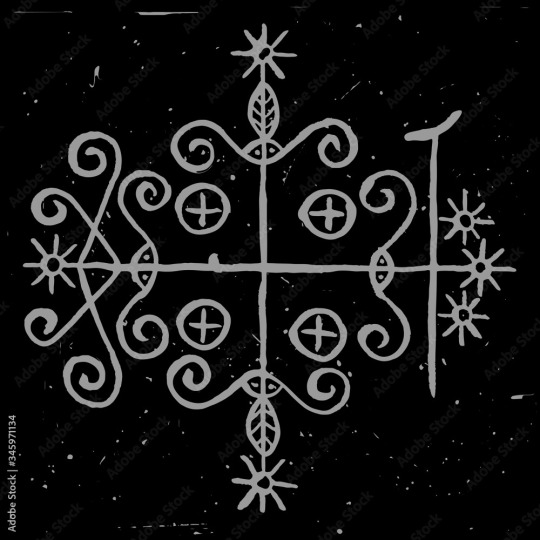

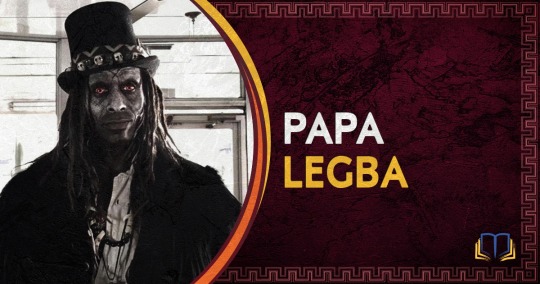
Does the Witch Doctor in Africa countries make Kabbalistic Pacts with the Devil like in Haitian Voodoo and Jamaican Obeah?
They most certainly do not make Kabbalistic Pacts with the Devil which is a Judeo Christian Islamic concept, which they were not, African priest and priestess doubled as healers both spiritual and physical , they understand there is a duality in nature as in the spiritual worlds one can tap into , eg Horus cannot exist without his polar opposite Set.
Now that said there are areas where both the Christian concepts became entwined with African religious concepts as in the cross roads and Papa Legba.
Because slave owners were worried about potential rebellion, they often separated enslaved people from the same area.
By mixing people from different regions and language groups, they could use the communication barrier to discourage or even prevent revolt. However, many of the deities were similar, and so enslaved people from different parts of Africa soon found commonalities in their spiritual beliefs and practices, which they were forced to keep hidden.
Papa Legba soon found a home in the religious structures of enslaved people in Haiti and the Caribbean, as well as in the American colonies. Author Denise Alvarado says Legba:
...stands at a spiritual crossroads and grants or denies permission to speak with the spirits of Guinee, and is believed to speak all human languages. He is always the first, and the last spirit invoked in any ceremony because his permission is needed for any communication between mortals and the loa—he opens and closes the doorway to the spirit world.
Over time, after African syncretic practices blended with Catholicism in the new world, Legba became associated with several saints, including Saint Peter, Saint Anthony, and Saint Lazarus.
In the Haitian religion of Vodou, Legba is seen as the intermediary between mortal men and the loa, or lwa. The loa are a group of spirits responsible for various aspects of daily life, and they are the children of a supreme creator, Bondye. They are divided into families, such as the Ghede and Ogou, and practitioners develop relationships with them through offerings, petitions, and prayers. Often, Papa Legba is the one who carries these prayers to the loa.
Note the cross roads would later become associated with the devil in this religious synchronism.
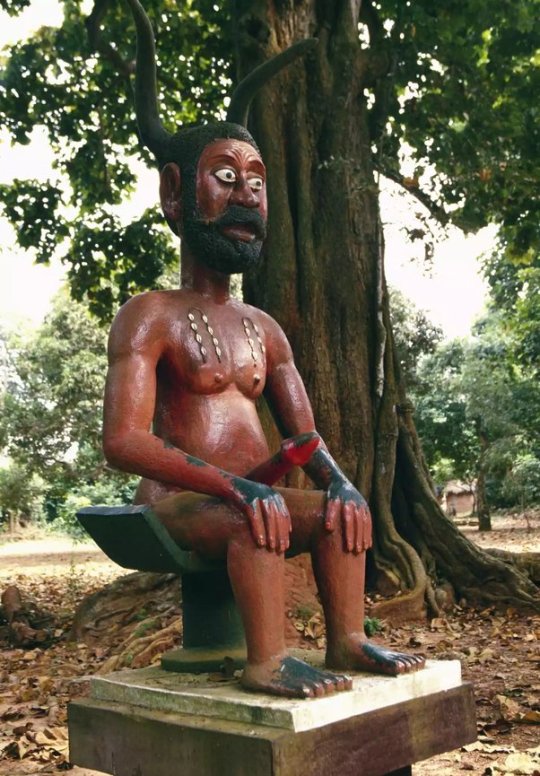
Statue of Legba as fertility god. Atlantide Phototravel / Getty Images Plus
Legba has evolved in numerous ways from his origins in Africa, where he is sometimes viewed as a fertility god or a trickster; he many be depicted as both male and female, sometimes with a large erect phallus. In other areas, he is a protector of children or a healer, and can grant forgiveness for crimes against others. Variants of Legba exist in many places including Brazil, Trinidad, and Cuba.
Papa Legba appears in many forms in New Orleans Voodoo and Haitian Vodou. He is typically depicted as an older man, sometimes wearing a straw hat or old tattered clothing, walking with a cane, and accompanied by a dog. He's associated with the colors black and red.
Legba is strongly associated with crossroads magic, and is referenced in a number of early twentieth-century blues tunes from the area of the Mississippi Delta. Famed bluesman Robert Johnson is said to have met a spirit at the crossroads, and offered him his soul in exchange for musical success. Although eventually the story was twisted to say Johnson met the Devil, musical folklorists believe that tale is rooted in racist ideology; instead, Johnson met Legba at the crossroads, where he had gone seeking guidance and wisdom.
Papa Legba is a master communicator, who is said to speak the languages of all human beings; he then translates petitions and delivers them to the loa. He is a teacher and warrior, but also a trickster deity. Legba is a remover of obstacles, and can be consulted to help find new, positive opportunities, thanks to his ability to open doors and new roads
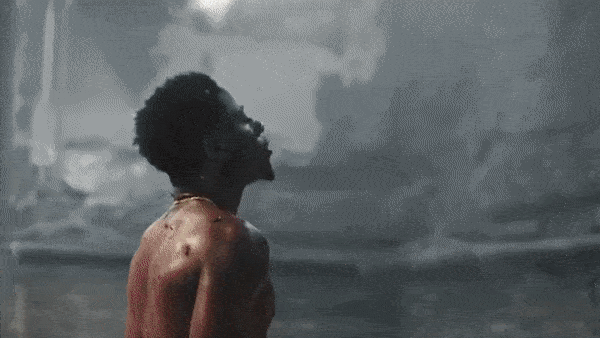
Legba represents a West African and Caribbean Voodoo god. This god has many different names depending on the region in which he is worshipped is most commonly known in Haiti as Papa Legba. Papa Legba serves as the guardian of the Poto Mitan--the center of power and support in the home. Additionally, he allows for communication between humans and the spirit world. According to West African Voodoo practices, spirits of the dead are not able to inhabit one's body unless permitted by Papa Legba. The symbol for Legba typically has a red background, one of his representative colors. The symbol includes several keys which signify Legba's control over communications and forms of passage, including locks, gates, and passageways;it also includes a cane, as Papa Legba is generally depicted as an old and feeble man in the Haitian religion. There are many chants to summon Papa Legba, one of which is: Papa Legba, Open the gate for me/Atibon Legba, Open the gate for me/Open the gate for me/Papa that I may pass/When I return I will thank the Lwa.

GYE NYAME - Supremacy of God
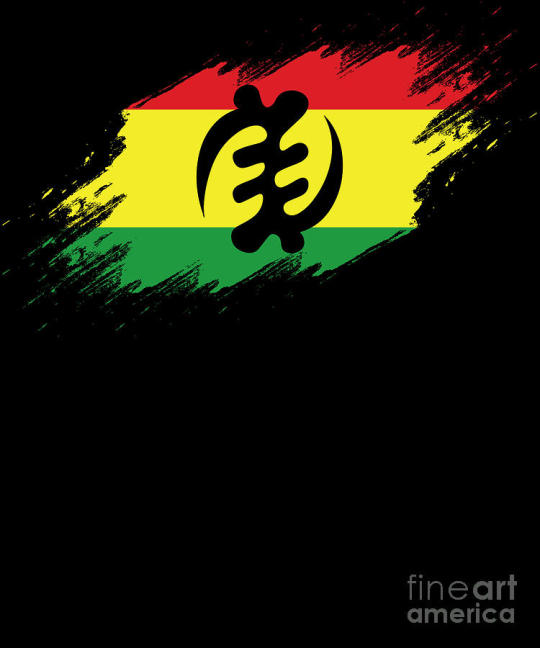
Gye Nyame, meaning “except for God,” symbolizes God’s omnipotence through the knowledge that people should not fear anything except for God. Another interpretation of “except for God” is that no one has seen the beginning of all creations, nor will anyone live to see the end, except for God. Gye Nyame indicates the recognition of the supremacy of God over all beings, and therefore is the one that is feared and revered by all. This is one of the many Adinkra symbols of West Africa, Ghana, and is used by the Akan people in various decorations, clothing, and artwork. Some say that the symbol represents a spiral galaxy, or two hands with different gestures that refer to God being supreme to the simplistic ideals of male and female identifications that are used today. The use of this symbol by the Akan people suggests that the Akan had a highly advanced writing language that transmitted religious and cultural concepts, and also might have had a somewhat extensive knowledge of astronomy, which shows their intellect and indicates that the Akan were a more advanced civilization.


Nkisi Sarabanda, symbolizing the signature of the spirit, is a representation of a bakongo cosmogram. This symbol portrays how the Congo-angolan people viewed the interaction between the spiritual and material world, or in other words between the living and the dead;the Congo-angolan people believe that these worlds are inherently intertwined. An Nkisi is a spiritual object used for worship purposes, and have been found in places where enslaved Africans have lived in, such as in the plantation homes. Nkisis show the development of African American culture in how they are essentially African objects, but are constructed through American materials. This also reveals an aspect of the melting pot of African and American culture. Sarabanda just connotes "the highest spirit". Part of the symbol takes the form of a cross, because the Congolese had an inclination towards Christianity. Communication appears to take place at the center of the cross, where the worlds intersect, and it was believed that spirits sat at the center of the sign. The arrows represent the four winds of the universe, and the symbol as a whole resembles the form of a spiral galaxy;this indicates their interest in astronomy and affinity towards nature.
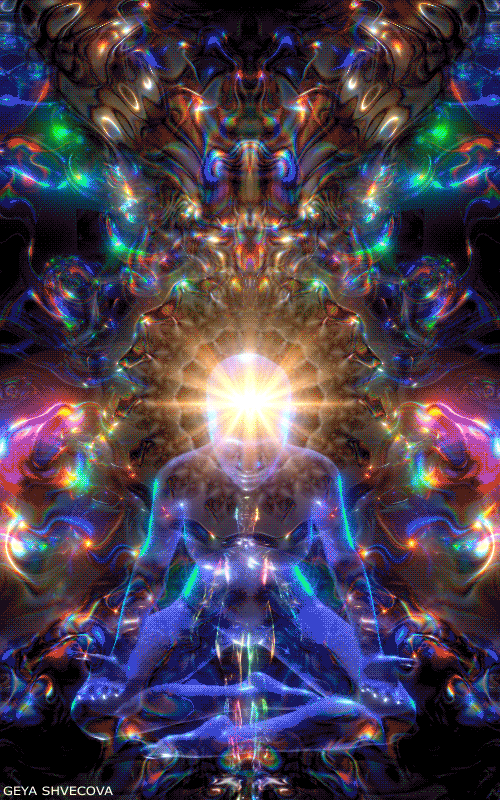
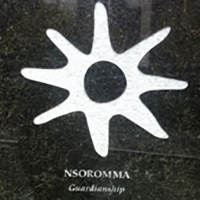
Nsoromma, meaning "children of the heavens" or "star," symbolizes the guardianship of God and how he watches over all beings. It is one of the many Adinkra symbols that the Ghanaian people have lived by. The protection of God is constant, like the stars in the universe. The stars also embody light, with the vision of light slicing through darkness as a savior, or protector. The symbol indicates the existence of the spiritual world, in which our ancestors and past families exist and watch over us, creating a feeling of safety and wholeness. Nsoromma expresses the message to live life to its fullest knowing that you are supported and strengthened by God.
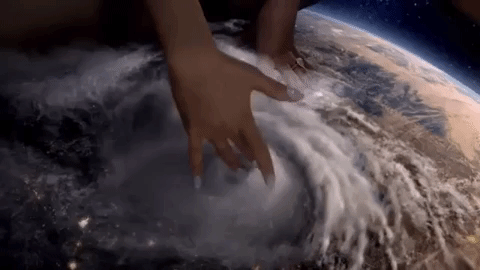

Divinity of Mother Earth
Asase Ye Duru—literally meaning “the earth has no weight”—is a symbol that represents power, providence and divinity. The symbol is one of many adinkras, or depictions of important concepts created by the Akan peoples of Ghana. Asase Ye Duru emphasizes the importance of the Earth and its preservation. People must respect and nurture the Earth, and should never act in ways that might directly or indirectly harm the Earth. The significance of the Earth to the people of Ghana is evident in the following proverbs: Tumi nyina ne asase, meaning All power emanates from the earth; and Asase ye duru sen epo, meaning The earth is heavier than the sea. The African Burial Ground honors these principles, as it surrounds itself with natural resources and emphasizes the cohesion of death and nature.

#vodun#african traditional religions#panafrican thought#kemetic dreams#asase#duru#akan#earth#ghana#nso#nsoromma#children of the heavens#nkisi#nkisi sarabanda#bakongo#bakongo symbolism#gye#gye nyame#legba#new orleans voodoo#haitian vodou#brazil#trinidad#cuba#denise alvarado#obeah#kabbalistic#odinani#horus#set
177 notes
·
View notes
Link

2 notes
·
View notes
Photo
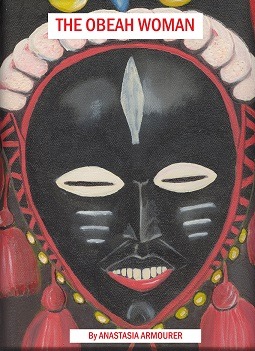
CHAPTER 1 Trinidad and Tobago lie at the northeastern corner of Venezuela from which it is separated by the Gulf of Pariah. It is the most southerly link of that beautiful chain of islands, which form a curved line starting at the top of the Florida Peninsula to the mouth of the Orinoco River called the West Indies. The island of Trinidad is rectangular in shape. It is 50 miles long and 37 miles wide, with a surface area of 1,863 square miles. The highest range of mountains, in the north, crosses the width of the island from Galena Point to Dragon’s Mouth. The only two clearly marked breaks in the hills are Tucker Valley and Diego Martin Valley. It is in Diego Martin Valley that Mother Dora, The Obeah Woman, lives. She is like a mother to all the people in Simian Village, for she brought 99% of them into this world. She cares for them with her healing herbs and she is there for them in times of trouble. No one knows how old Mother Dora is. To look at her, one would say she is in her late fifties. She stands about five foot six inches and weighs one hundred and sixty pounds. Her head is tied up in a bright red and white floral head wrap which is the same pattern as her dress. She pulls her black shawl about her shoulders, and takes her medicine basket in her hand. It is the dry season, and the Trade Winds are blowing through the trees as she steps out of her house. The smell of her garden always brings a smile to her face. She walks around to the back of her house, quickly picking a few fresh herbs for her basket. Now she is ready and it is time. She places her basket on her head and walks briskly along the path that leads to Simian Village. As she walks, the wind swirls about her kissing her cheeks and tugging at her skirts like an impatient lover. She smiles and sang a love song to the Great Spirit in the wind. The dirt road turns sharply to the right. She walked quickly as she approached the house of Shanka, a Portuguese man whose wife was in her eighth month of pregnancy. It was after midnight, and all the lights in the house were on. She could hear the cries of Shanka’s wife, Gloria, in pain. She heard Shanka’s mother-in-law saying, “Shanka, you’ve got to get Mother Dora! She will know what to do! It’s all too soon!” “You have four more weeks yet!” Mother Dora stood outside the door. It swung open and the tall man stared into her smiling face with deep astonishment. She walked forward and touched his shoulder. “It will be alright.” She said, as she walked past him into the house. 5 “Hot coals!” she commanded to Shanka’s mother-in-law, Edna, who leaped to her feet and ran outside to the still shouldering fire pit. She put some of the coals into a flat pan and brought them to Mother Dora. The house had two bedrooms, a living room and a kitchen. Mother Dora put incense on the hot coals. Soon, the whole house was full of smoke. Then she started to sing as she opened all the windows and doors of the house. She then took a white bottle from her basket and poured its contents in a wooden bowl. Finally, she sprinkled the house and everyone in it, with a bundle of fresh herbs. Shanka sat on his living room sofa, holding his two sons. Jessie the oldest, was six. Martin was two. Edna sat on the bed, trying to comfort her daughter. “It’s alright girl. Mother Dora is here.” Somehow, she knew to come just now.” She wet her daughter’s forehead with a damp cloth. Dora took a small black bottle from her basket. She held it firmly as she walked over to the southwest corner of the bedroom. She stood facing the corner as though standing in front of a person. “You get out from here right now!” she commanded in a low, hard voice, as cold as water in a cellar. “I know Cocoka sent you and I know why, but you ain’t going to succeed here tonight. So get out! Get out now!! I say GO!!! She walked around the room sprinkling the content of the bottle on some invisible person. Then she closed all the windows and doors and started singing again as she put the contents of the black bottle on the doors and windows. Next, she anointed the foreheads of every person in the house with blessed oil. “Now, we must stop these labor pains, “she poured the content of a blue bottle into a clay mug and handed it to Edna. “She got to drink all this.” Edna took the mug and fed the drink to Gloria, who was still crying out from her pains. Dora placed two lighted white candles on the floor on each side of the bed, and then she placed one lighted blue candle at the foot of the bed. Then she placed the pan of hot coals next to the candle, and burned the fresh herbs on them. The smoke perfumed the air as Dora sat up in front of the candle, singing, with her medicine basket next to her on the floor. She looked at Gloria on the bed, whose cries became a low moan, showing that the pain was subsiding. Edna was wiping her daughter’s forehead when a loud bang from someone, or something, hit the roof of the house. 6 Shanka ran into the bedroom, a look of horror on his face. Edna and Gloria clung to each other in terror. The sounds of scraping and scratching as if something with long claws was trying to scratch a hole through the galvanized roof. Gloria screamed again. Dora stood to her feet and intercepted Shanka as he rushed towards his wife. “You broke your contract with Cocoka, didn’t you? “Now she wants revenge!” Shanka looked with astonishment into the gray, piercing eyes of Mother Dora. He opened his mouth to confirm her statements, but no sound came from his lips. He only nodded his head as tears fell from his eyes. Gloria was now howling in pain. Dora rushed to her, took a necklace of multicolored stones from around her neck and placed them on Gloria. They stopped her screams instantly. Panting heavily and placing her hands on her belly, Gloria cried between breaths, “The child…., the child is coming!” Dora rushed to her basket and took out a red root. “Eat this!” Gloria ate the gnarled plant with haste. Dora placed her hands on the woman’s belly and said, “STOP!” “Stop Now! It is not yet time! Wait a little bit longer.” With these words, the pains stopped. Gloria looked at the woman whose hands had brought her and her two children into this world. “Thank you, Mother,” she whispered. The gentle woman smiled at her and wiped away her tears. “This child will not come before her time, nor will she die.” She smiled at Gloria reassuringly. Suddenly, screams came from the living room. “Stay here with her.” Dora said to Edna, as she and Shanka ran to find the two boys doubled in pain. “Go bring my basket.” Shanka rushed back to the bedroom as Dora Scooped his sons into her arms and held them to her. Shanka brought the basket and placed it before the woman on the floor. “You are a damn fool, Shanka!” He glared at her, not knowing how to respond. Her eyes blazed with anger. “You were a fool first of all to go to Cocoka, and even a bigger fool to sell her you’re first born, and for what?” “I was desperate,” he shouted. “She gave me the money I needed for my shop! I had to make a life for my family!” “Money, money! It’s always money!” she howled at him. “Give me that little black bag,” she pointed with her head and eyes to the basket. Shanka handed her the little black bag. 7 She set the boys on the floor in front of her. Then she made a circle around the man and his sons. “You stay here in this circle and do not move until I come back inside.” The boys stopped crying as they held onto their father. The scratching on the roof became louder and more intensified. Dora reached into her basket and took out three small black stones and spoke some words to them in pattwa. After this, she left the house, locking the door behind her. All around was still and heavy. She could feel the evil presence of Cocoka the Sukkunya, the witch of black magical arts. She held her body erect and walked a little way from the house. Standing straight and still, she turned and looked at the rooftop. In the light of the moon she saw her. It was Lilith! A horrible winged demon with sharp claws on her feet. She was scratching at the tin plates of the roof, moving in a circle, in a horrible rage. Dora opened her hand. One of the stones rose out of her hand and flew towards the demon. The stone turned into a blaze of fire as it flew through the dark. The horrible form was struck under her right wing and she let out a great screech. She turned and looked at Dora, only to see another fireball coming. The ball hit the demon square on the back as it tried to avoid the attack, it ripped off a piece of roofing, howling in agony. “You tell Cocoka that I have put my seal on this house and she must deal with me now.” The Last fireball struck the demon on the butt as it flew into the night, screaming. Shanka sat on the floor, sobbing over his sons. He looked up with a start as Mother Dora re-entered the house. “You are right, Mother,” he said, weeping and rocking his sons back and forth in his arms. “I am a fool I can’t believe I have done this horrible thing. What was I thinking of?” “Money!!! Snarled Dora. “You were so blinded by the idea of having your own shop and all the money it could bring you, that all Cocoka had to do was put the idea of what she wanted into your head and you were willing to give it. But, the witch didn’t count on me getting involved in all of this.” Mother Dora walked past him and went into the bedroom. Gloria just went off to sleep, just like that, once the screaming stopped outside. “What was that sound?” Edna asked, as she pulled the cover over her daughter’s still body. Dora did not answer. “I will go and put the boys to bed, if it is safe now.” Said Edna knowing not to push the issue. “Send Shanka in here,” Dora said sternly. 8 When the man stumbled into the room, Dora was gathering her things. “Look at her,” Dora said to him, as she pulled him to the bed. “She is a beautiful black woman and she loves you very much. Now you are basically a good man, Shanka, and you have a beautiful family. Now, because of your stupidity, you almost lost them all tonight. Just remember this, young man. If you ever do something his asinine ever again, believe me, you’re going to deal with it yourself.” Dora then sat with Gloria for a few hours to make sure she was alright. She then left Shanka’s house. She took four small stones from her basket, spoke to them and buried them in the ground at the four corners of the house. Then placing her basket on her head she set out down the path for home. The sky was purple in the east, and a few of the stars could still be seen in the west, as the dawn of a new day greeted the Valley. The air was cold and chill, and she pulled her black shawl around her as she walked briskly along the dirt road. She knew that her lifelong enemy, Cocoka, now had one more reason to hate her. Mother Dora would have to battle the evil Sukkunya again, and soon. The fragrant smell of her garden greeted her and the dew on the rose bushes lining the path to her house look like diamonds in the first dawn light. She smiles as she walks by them into her house. She will turn in now and rest in the beauty of her home, for in her heart, she knows, that soon she must face Cocoka and pay the reckoning for the broken contract. (WANT MORE OF THE STORY? WANT MORE OF “THE OBEAH WOMAN” BY ANASTASIA ARMOURER? BUY YOUR COPY NOW AT AMAZON! HARD COPY OR KINDLE!!) JUST CLICK THIS LINK: https://www.amazon.com/.../ref=cm_sw_r_fa_dp...
4 notes
·
View notes
Link
The Merikins or Merikens[1][2] were African-American Marines of the War of 1812 – former African slaves who fought for the British against the USA in the Corps of Colonial Marines and then, after post-war service in Bermuda, were established as a community in the south of Trinidad in 1815–16. They were settled in an area populated by French-speaking Catholics and retained cohesion as an English-speaking, Baptist community. It is sometimes said that the term "Merikins" derived from the local patois, but as many Americans have long been in the habit of dropping the initial "A" it seems more likely that the new settlers brought that pronunciation with them from the United States. Some of the Company villages and land grants established back then still exist in Trinidad today. During the American Revolution, the British recruited Freedmen.[3] After that war, the British settled the Marines in colonies of British Empire including Canada, Jamaica and the Bahamas.[3] During the War of 1812, there was a policy that was somewhat similar except that Freedmen were treated as free as soon as they came into British hands and there were no conditions nor bargains attached to recruitment. Six companies of Freedmen were recruited into a Corps of Colonial Marines along the Atlantic coast, from Chesapeake Bay to Georgia.[3][4]Vice Admiral Sir Alexander Cochrane, on taking over the command of British forces on the North America station on 2 April 1814, issued a proclamation offering a choice of enlistment or resettlement:[3]... all who may be disposed to emigrate from the UNITED STATES will, with their Families, be received on board His Majesty's Ships or Vessels of War, or at the Military Posts that may be established, upon or near the Coast of the UNITED STATES, when they will have their choice of either entering into His Majesty's Sea or Land Forces, or of being sent as FREE Settlers to the British Possessions in North America or the West Indies, where they will meet with due encouragement ...Cochrane's recruitment of the Colonial Marines, mostly in the Chesapeake, went doubly against his orders from the British government, who had instructed him to accept volunteers for military service only from Georgia and South Carolina and to send all such volunteers away immediately for training overseas for the Army.[4][5]After the end of the War, the Colonial Marines were first stationed at the Royal Naval Dockyard, Bermuda. Although they had signed on for a military life, they rejected government orders to be transferred to the West India Regiments, and finally agreed to be settled in Trinidad and Tobago.[4]The Governor of Trinidad, Sir Ralph Woodford, wanted to increase the number of small farmers in that colony and arranged for the creation of a village for each company on the Naparima Plain in the south of the island.[3] Local planter Robert Mitchell managed the establishment and maintenance of the settlements, petitioning the governor for supplies when needed.Unlike the American refugees who were brought to Trinidad in 1815 in ships of the Royal Navy, HMS Carron and HMS Levant, the Veteran Marines were brought there in 1816, with their families, in the hired transports Mary & Dorothy and Lord Eldon .[6][7][8] There were 574 former soldiers plus about 200 women and children.[3] To balance the sexes, more black women were subsequently recruited – women who had been freed from other places such as captured French slave ships.[3] The six companies were each settled in a separate village under the command of a corporal or sergeant, who maintained a military style of discipline.[3] Some of the villages were named after the companies and the Fifth and Sixth Company villages still retain those names.[3][4]The villages were in a forested area of the Naparima Plain near a former Spanish mission, La Misión de Savana Grande.[9] Each of the Veteran Marines were granted 16 acres of land and some of these plots are still farmed today by descendants of original settlers.[7][9] The land was fertile but the conditions were primitive initially as the land had to be cleared and the lack of roads was an especial problem.[9] It is sometimes said that some of the settlers were craftsmen more used to an urban environment and, as they had been expecting better, they were disgruntled and some returned to America,[8] but this comment applies to later free Black American settlers, who came from towns, and not to the Veteran Colonial Marines, who were all refugees from the rural areas of the Cheasapeake and Georgia. The settlers built houses from the timber they felled, and planting crops of bananas, cassava, maize and potatoes.[3] [4] Rice was introduced from America and was especially useful because it could be stored for long periods without spoiling.[3]Twenty years after the initial establishment, the then governor Lord Harris supported improvements to the infrastructure of the settlements and arranged for the settlers to get deeds to their lands, so confirming their property rights as originally stated on arrival, though it is not clear that the initiative was carried through universally.[7][3] [4] As they prospered, they became a significant element in Trinidad's economy.[3] Their agriculture advanced from subsistence farming to include cash crops of cocoa and sugar cane.[3] Later, oil was discovered and then some descendants were able to lease their lands for the mineral rights.[3] Others continued as independent market traders.Many of the original settlers were Baptists from evangelical sects common in places such as Georgia and Virginia.[3] The settlers kept this religion, which was reinforced by missionary work by Baptists from London who helped organise the construction of churches in the 1840s.[3] The villages had pastors and other religious elders as authority figures and there was a rigorous moral code of abstinence and the puritan work ethic.[3] African traditions were influential too and these included the gayap system of communal help, herbal medicine and Obeah – African tribal science.[3] A prominent elder in the 20th century was "Papa Neezer" – Samuel Ebenezer Elliot (1901–1969)[10] – who was a descendant of an original settler, George Elliot, and renowned for his ability to heal and cast out evil spirits.[3] His syncretic form of religion included veneration of Shango, prophecies from the "Obee seed" and revelation from the Psalms.[3] The Spiritual Baptist faith is a legacy of the Merikin community.[11][12]
Famous Merikins[edit]The following people are descended from this community:Tina Dunkley, American museum director[13]Hazel Manning, Trinidadian senator and education minister[13]Althea McNish, British textile designer[14]Brent Sancho, footballer, Minister for Sport for Trinidad and Tobago
10 notes
·
View notes
Photo

S E X Y P I N K
YOU AND IMELDA WERE NEVER ALONE by Brianna McCarthy acrylic on canvas size 10“ x 10“


The Trinidad and Tobago Artist Brianna McCarthy tells sexypink a bit about her two pieces in the Lord Kitchener show just concluded at A Space Inna Space in Woodbrook.
You and Imelda Were Never Alone The entirety of Lord Kitchener’s Love in the Cemetery has always intrigued me.
It builds a world of death, ritual and Obeah; and also of intrigue and entrapment. For this instance, the lines “I felt like a king upon de throne Me and Imelda liming alone When I heard a talk And a creeping walk As I look around frightfully I was in the center of the cemetery” made me think that perhaps, Imelda, knowing him to be an impish young man, worked in tandem with the cemetery denizens to teach him a lesson. It made me think that, Imelda, having never been mentioned again in the escape, was a cemetery denizen herself.
Of course, she was more than likely left on top a mister’s grave by the fleeing Kitch. Out of the opening lines of this piece, I was inspired by the “heard a talk” and “a creeping walk” juxtaposed with the previous “me and Imelda liming alone”. He and Imelda were never alone. These pieces can also be called “A talk” and “A Creeping Walk” — a visual representation, in corbeaux feathers and questionable halos, of the reason he and Imelda were never alone.
#sexypink/Brianna McCarthy#sexypink/You and Imelda were never alone#sexypink/The Lord Kitchener Show 2022#sexypink/painting/Lord Kitchener#tumblr/Brianna McCarthy#Brianna McCarthy#tumblr/Lord Kitchener#Lord Kitchener#painting#100 years of Lord Kitchener
1 note
·
View note
Text
Obeah
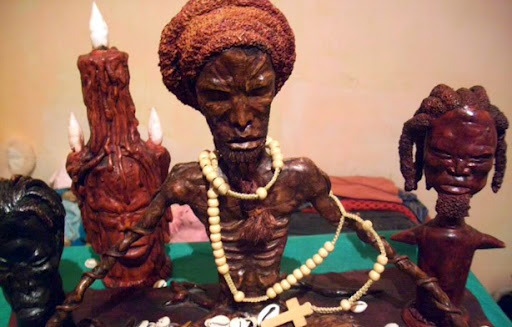

The practice of harnessing supernatural forces and spirits for one’s own personal use, known in some parts of Africa as ‘Obeye’ (an entity that lives within witches), has taken on many names in the Caribbean islands, such as Shango (Trinidad), Santeria (Cuba), Vodun or Voodoo (Haiti), Ju-Ju (Bahamas), Obeah (Jamaica),. Although African slaves usually practiced Obeah for "evil" or rather self-interested, instrumental purposes, this faith also aided them as a source of strength and clandestine resistance. The practice of Obeah is the belief that one can use certain spirits or supernatural agents to work harm to the living, or to call them off from such mischief. Generally, the British used the term Obeah to describe all slave acts and practices that were considered supernatural or evil in nature, such as rituals and fetishes.
Modern historians believe that Obeah originated from the Ashanti and Koromantin tribes of Africa on the Gold Coast, and that imported slaves introduced it to the Caribbean as early as the mid 17th century. Regardless of its use, for ‘evil’ or ‘good’, the Obeah men were treated with the utmost respect and fear by all whom met him. The Obeah man and women played a prominent role in the Caribbean slave societies from the beginning of the slave trade. They functioned as community leaders and teachers of the African folk’s cultural heritage. Many Africans believed that the Obeah man had within his power the ability to render someone invincible, resuscitate the dead, cure all diseases, protect a man from the consequences of his crimes, and cause great harm to anyone he wished. Yet the Obeah man’s most powerful gift was not his ability to steal people’s shadows , as the act of obeah or "hexing" was described, but his intricate knowledge of herbs and poisons. The term Obeah also suggested the word "poison" in the Caribbean plantations, this being the preferred and most effective tool that this practitioner of "magic" had at his disposal. Through the use of herbs and medicine, the Obeah man, was able to "miraculously" cure or poison (obeah) a person to death. Considering the development and practices (bloodletting) of "modern" European medicine at the time, an ill person had a much greater chance of survival by seeking out an Obeah man rather than a white physician.
60 notes
·
View notes
Photo
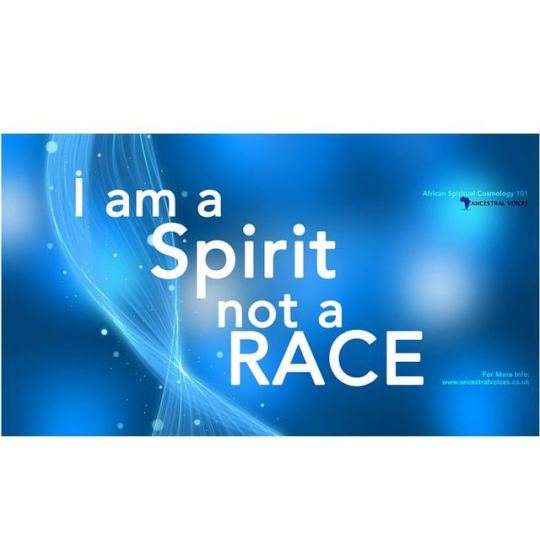
African Spirituality Philosophy 101 Essence of all beings is the same, its man who constructs the difference! #ifa #akan #kemet #kemetmysteryschools #zulu #congo #bakongo #vodou #vodoun #santeria #umbanda #espiritismo #macumba #palo #palomayombe #candomble #lucumi #winti #comfa #obeah #juju #pocomania #africa #ghana #nigeria #southafrica #europe #haiti #brazil #cuba #jamaica #trinidad #tobago #guyana #egypt #AncestralVoices #Ancestralvoices2 #ritualsforliving #blackhistorymonth
#blackhistorymonth#bakongo#nigeria#zulu#tobago#akan#palo#ancestralvoices2#southafrica#juju#obeah#candomble#guyana#ancestralvoices#vodou#jamaica#haiti#lucumi#europe#congo#kemet#ghana#santeria#comfa#espiritismo#winti#egypt#trinidad#palomayombe#brazil
28 notes
·
View notes
Text

Obeah Man, answer the question - Trinidad & Tobago Express http://dlvr.it/R0RdCJ http://dlvr.it/R0RdCJ
0 notes
Text
Happy Caribbean Heritage Month!
Also, welcome back to the return of Astro-Caribbean!
All this month, I will present visionary work from the Afro-Caribbean diaspora. Today’s post is a presentation of visual artists — Sheena Rose, Carlo Theartus, Dirk Joseph, and Alicia Brown.
Sheena Rose
Sheena Rose is a Barbados-based artist whose work explores the cultures of the Caribbean and challenges of being part of the Caribbean diaspora. The work below is from her Black Obeah series, which includes her “Island and Monster” triptych and comments on her conflicted feelings as someone who went to the U.S. and now has returned to Barbados. She was recently featured in NY Times for her performance that she did at MoCADA yesterday.
“Black Obeah
This magic moment I sang to myself as I was going
through some serious anxiety and had this serious
fear of returning back back home. I felt like I was
going through something magical, scary and surreal
in my head. I felt like an outsider, a monster and an
astronaut and and I decided to put a spell on the
viewers to join my magical world.”
This slideshow requires JavaScript.
Carlo Thertus
Carlo Thertus is a New York-based Haitian artist and executive director of Creative Art Space for Kids, Inc. in Oceanside, N.Y. This month he will be honored at the Caribbean Chamber of Commerce for his work.
From his artist statement: “Man must become more aware of his environment. Nature and world politics are both in a fragile state. We must find harmony to exist. Hand in hand, people of all races have to unite to save our planet (humanity). I have seen too much violence. Consciousness should be just and peaceful and energy should be used positively.
Coming from total ignorance out of the jungles and caves, we managed to evolve to where we are, as we are the only species with the gift of imagination, intelligence, knowledge. Today, the world of the twenty-first century is “the Fourth Dimension” of time.
We are at the center of relativity with the gift of being human, a gift that we still cannot reason with… So much hate even between religions that are worshiping the same God. Today, men are no longer revindicate with the sword, with our new wealth of knowledge we are taking baby steps into a new frontier. According to the laws of general relativity, humanity’s consciousness is not in relativity to its time — its evolution.
One would do this equation of RELATIVITY + HUMANITY + TIME + EVOLUTION = …”
This slideshow requires JavaScript.
Dirk Joseph
Dirk Joseph is a multimedia artist who works in mediums including painting, sculpting and computer animation as well as a performance artists. He was born in Trinidad, grew up in New York and now lives in Baltimore.
“I paint to record dreams and experience. I paint to create dreams and experience.”
This slideshow requires JavaScript.
Alicia Brown
Alicia Brown is a Jamaica-based artist and art educator.
Artist Statement: “We inhabit an elusive space, where there is an ongoing struggle to find the missing pieces of self. We are all on the journey to be accepted and to feel a sense of belonging.
My work is about mimicry – what it means to mimic, the implications of employing this tool in the process of constructing postcolonial Caribbean identity, and the significance of this idea in a twenty-first-century art context. We are all aware of the narratives surrounding the issues regarding the influence of colonialism, mass media, pop culture, Western trends and their impact on the formation of identity, but who is telling the story and from what point of view? I would like to tell a story . . .
The act of copying or imitating a dominant culture is evident in the formation of subcultures resulting from class distortions associated with colonialism. With this in mind, I create works surrounding this duality that plays a vital role in the formation of cultural identity, a product that is constantly changing and not fixed. There is an obsession with the need for acceptance and belonging, and I use my works to add to the ongoing dialogue on the subject of cultural identity and representation…”
This slideshow requires JavaScript.
Astro-Caribbean Series: Art of This World! Happy Caribbean Heritage Month! Also, welcome back to the return of Astro-Caribbean! All this month, I will present visionary work from the Afro-Caribbean diaspora.
#A Future Ancient#Alicia Brown#art#Astro-caribbean#Caribbean#Caribbean futurism#Carlo Thertus#Dirk Joseph#Futuristically Ancient#Sheena Rose#Visual Art
7 notes
·
View notes
Text
Benefits of Obeah Removal in USA
Are you looking for Obeah Removal in USA? Obstacles and diversities are not common in our life. However, sometimes, they may be created via way of means of a few mischievous those who aren't satisfied due to our happiness. When the negativity turns into a hurdle in life, you want the assist of someone, who can come to be the actual braveness in hard times.
What is Obeah?
Obeah may be described as a unique act of supernatural pastime that prevails in African and Caribbean countries. There are professionals that may keep off evil powers and limit the bad strength. By the use of our high-quality strength and non-secular powers, we convey contentment and smiles to the faces in their clients. Obeah is the name of the game evil pressure; this is difficult to tackle. It is due to the fact frequently the supply or evil pressure is unknown. Therefore, the consequences of Obeah Black Magic may be diverse. Experts say that obeah spells are the maximum dangerous ones. They can convey loads of hurdles and unexpected issues.
An individual can revel in numerous issues in life, and they may preserve coming. You want a person who can overpower it and make you safe. To triumph over the detrimental powers, you want a similarly effective high-quality pressure. When you get an Obeah specialist, he can spot wherein is the supply of the problem. The powers and information of Obeah Man or Obeah female assist in getting rid of the unwell consequences completely. Assured practices are assured with the aid of using our specialist. We are obeah people and feature presence in all around the international together with Australia, Jamaica, USA, Canada, New Zealand, Guyana, Trinidad and Tobago, African Countries, Caribbean Countries etc.
For higher and everlasting safety in opposition to the so-called ‘black magic” or “evil spirits”, you want a real Obeah female, who's knowledgeable. She must be an available and thoughtful individual. In the cutting-edge generation of the Internet, you want now no longer be bodily present. Regardless of a part of the phrase you live, you may get on-line assist from us. We are to be had for on-line session and our obeah guy touch wide variety is indexed above. A skilled Obeah guy gets the guidelines without delay if there's a presence of black magic, witchcraft, demons, devils or evil spirit. Sometimes, someone with a terrible aim casts a spell. It captures the thoughts of the individual, and he behaves in an extraordinary manner. The persona modifications completely. An Obeah guy can clear up a majority of these topics with the aid of using the use of his unique Obeah powers.
Obeah came into lime light during the era of slavery, but it has virtually gone in urban centers, where over half the Jamaican population now live. It has sustained in rustic communities though, and discovering an Obeah man is a relatively simple job.
Natives find out a property that is surrounded by a corrugated metal fence, painted in bright blue and yellow. It is not a subtle location for a man who takes part in unlawful action. Visit our official website now for Obeah Removal in USA.
0 notes
Text
African- influenced religions
The Shouter / Spiritual Baptist religion of the South Caribbean (namely Grenada, Barbados, St Vincent and Trinidad and Tobago) is a Christian-based religion giving primary diversion to this Holy Spirit but at the same time it has adopted African traditional forms of worship such as emotional singing chanting drumming and dancing. It is also African in being a complete and comprehensive belief system that through all aspects of life. The Orisha faith has its roots in the Yaruba traditions of West Africa
These religions are called Syncretic religions as they incorporate seemingly opposing beliefs (eg Christianity)
During colonial times and slavery of the African people in the Caribbean were prohibited from practicing any part of their religion. They were accused of using black magic, voodoo and obeah as a form of evil doing. This was misinformation is still being passed around the Caribbean today.
persecuted or severely punished if they were caught practicing their religion. They were beaten, arrested, fined and jailed and their houses of worship destroyed.
In the colonial Caribbean, grassroots religions such as the Shouter Baptist, Myal and Revivalism were viewed by the majority of population to be inferior to established religions.
“During a recent trip, while we were on our way to the holy site, my driver, who had been instructed by my colleague at the University of Trinidad and Tobago to pick up the priest on the way, was very uncomfortable. He is a Christian Indo-Trinidadian whom I have known and worked with for many years. He took me aside to warn me of the danger “these people” posed. When we arrived at the holy site, several leaders of the community were there to greet us. They talked about the fear surrounding their faith and while it is unfounded and based on misunderstandings, there are advantages of that fear. The owner of the property told me “no one steals from my land, they are too afraid.” He said this with a smile on his face, clearly amused. He even shared a story about a man who cut his foot on some building material while walking uninvited across his property. The man supposedly got an infection and died. He laughed about how that story gets told and how one man’s bad luck is attributed to a misunderstood religion.”
As seen from this extract, the mistrust and intolerance are as clear as day. The priest is completely aware of the stereotypes which is placed on his religion and uses it to his advantage. This is because of the decades of rumors that have been circulating the region since the colonial era. This the reality of African influenced religions in society today and how they are portrayed in media today. They are viewed as a group that do Obeah for evil and randomly “catching power”. when they are simply a passionate send emotional religious group.
1 note
·
View note